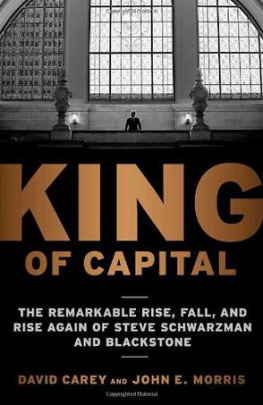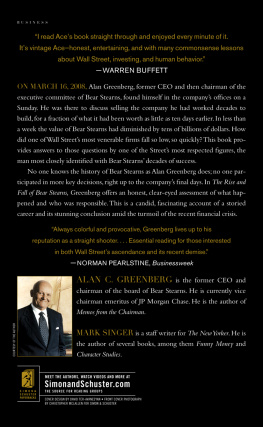David Carey - King of Capital: The Remarkable Rise, Fall, and Rise Again of Steve Schwarzman and Blackstone
Here you can read online David Carey - King of Capital: The Remarkable Rise, Fall, and Rise Again of Steve Schwarzman and Blackstone full text of the book (entire story) in english for free. Download pdf and epub, get meaning, cover and reviews about this ebook. City: New York, year: 2013, publisher: Crown Business, genre: Detective and thriller. Description of the work, (preface) as well as reviews are available. Best literature library LitArk.com created for fans of good reading and offers a wide selection of genres:
Romance novel
Science fiction
Adventure
Detective
Science
History
Home and family
Prose
Art
Politics
Computer
Non-fiction
Religion
Business
Children
Humor
Choose a favorite category and find really read worthwhile books. Enjoy immersion in the world of imagination, feel the emotions of the characters or learn something new for yourself, make an fascinating discovery.
- Book:King of Capital: The Remarkable Rise, Fall, and Rise Again of Steve Schwarzman and Blackstone
- Author:
- Publisher:Crown Business
- Genre:
- Year:2013
- City:New York
- Rating:3 / 5
- Favourites:Add to favourites
- Your mark:
King of Capital: The Remarkable Rise, Fall, and Rise Again of Steve Schwarzman and Blackstone: summary, description and annotation
We offer to read an annotation, description, summary or preface (depends on what the author of the book "King of Capital: The Remarkable Rise, Fall, and Rise Again of Steve Schwarzman and Blackstone" wrote himself). If you haven't found the necessary information about the book — write in the comments, we will try to find it.
Abstract: Strippers and Flippers ... or a New Positive Force Helping to Drive the Economy ... The untold story of Steve Schwarzman and Blackstone, the financier and his financial powerhouse that avoided the self-destructive tendencies of Wall Street. David Carey and John Morris show how Blackstone (and other private equity firms) transformed themselves from gamblers, hostile-takeover artists, and barbarians at the gate into disciplined, risk-conscious investors. The financial establishmentbanks and investment bankers such as Citigroup, Bear Stearns, Lehman, UBS, Goldman Sachs, Merrill Lynch, Morgan Stanleywere the cowboys, recklessly assuming risks, leveraging up to astronomical levels and driving the economy to the brink of disaster. Blackstone is now ready to break out once again since it is sitting on billions of dollars that can be invested at a time when the market is starved for capital. The story of a financial revolutionthe greatest untold success story on Wall Street: Not only have Blackstone and a small coterie of competitors wrested control of corporations around the globe, but they have emerged as a major force on Wall Street, challenging the likes of Goldman Sachs and Morgan Stanley for dominance. Great human interest story: How Blackstone went from two guys and a secretary to being one of Wall Streets most powerful institutions, far outgrowing its much older rival KKR; and how Steve Schwarzman, with a pay packet one year of $398 million and $684 million from the Blackstone IPO, came to epitomize the spectacular new financial fortunes amassed in the 2000s. Controversial: Analyzes the controversies surrounding Blackstone and whether it and other private equity firms suck the lifeblood out of companies to enrich themselvesor whether they are a force that helps make the companies they own stronger and thereby better competitors. The story by two insiders with access: Insightful and hard-hitting, filled with never-before-revealed details about the workings of a heretofore secretive company that was the personal fiefdom of Schwarzman and Peter Peterson. Forward-looking: How Blackstone and private equity will drive the economy and provide a model for how financing will work
David Carey: author's other books
Who wrote King of Capital: The Remarkable Rise, Fall, and Rise Again of Steve Schwarzman and Blackstone? Find out the surname, the name of the author of the book and a list of all author's works by series.







